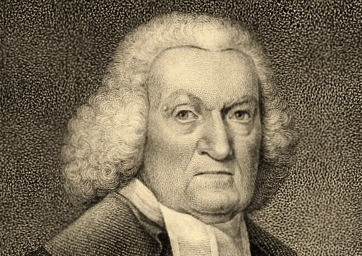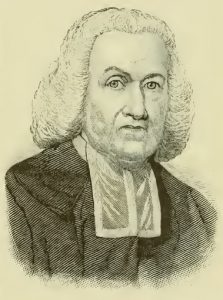 John was born in Boston on August 5, 1727, to Thomas and Elizabeth Baxter Rodgers. Within a few months, the family including two sons and six daughters moved to Philadelphia. When he was about twelve years of age, John had several opportunities to hear George Whitfield preach and it was during this time that he professed faith in Christ and shortly thereafter devoted himself to preparation for the ministry. Studies began with the biblical languages taught by Mr. Stevenson who operated a school in Philadelphia. Staying there for only a few months, he changed to a school in Neshaminy led by a Presbyterian minister named Roan. Rodgers left Neshaminy in the summer of 1743 to continue studies with Rev. Samuel Blair in Chester County. Rodgers did not receive a formal college education but Samuel Miller says of him that “he certainly received an education incomparably better than what usually passes under that title” (20).
John was born in Boston on August 5, 1727, to Thomas and Elizabeth Baxter Rodgers. Within a few months, the family including two sons and six daughters moved to Philadelphia. When he was about twelve years of age, John had several opportunities to hear George Whitfield preach and it was during this time that he professed faith in Christ and shortly thereafter devoted himself to preparation for the ministry. Studies began with the biblical languages taught by Mr. Stevenson who operated a school in Philadelphia. Staying there for only a few months, he changed to a school in Neshaminy led by a Presbyterian minister named Roan. Rodgers left Neshaminy in the summer of 1743 to continue studies with Rev. Samuel Blair in Chester County. Rodgers did not receive a formal college education but Samuel Miller says of him that “he certainly received an education incomparably better than what usually passes under that title” (20).
Young Rodgers went on to study theology with the pastor of Second Presbyterian Church in Philadelphia, Gilbert Tennent. After supplying several churches in New Castle Presbytery for brief tenures, Rodgers went with Samuel Davies to Virginia. Davies was moving to Virginia to accept a four-congregation call in Henrico County. However, there was considerable trouble with the duo’s entrance into the colony because it was a Church of England stronghold. Even though the governor was sympathetic to their request for permission to minister, there were other officials that opposed their ministry in the colony. After some discussion with the authorities and administrative buck passing, Davies was allowed to preach as a Presbyterian in the colony, but Rodgers had to leave. Having one door closed, he found another way to minister by supplying pulpits in Somerset County, Maryland, for about four months in 1748.
In the fall of the same year, John Rodgers left Maryland for other ministry opportunities. He was confronted with four call opportunities from which he selected the one to St. George’s in New Castle County, Delaware. He was ordained and installed in the church by the Presbytery of New Castle, March 16, 1749. His mentor, Samuel Blair, presided in the laying on of hands by presbytery, and the sermon was delivered by Samuel Finley. While Rodgers served the St. George’s congregation he married Elizabeth Bayard in a service conducted by his friend, Samuel Finley. Elizabeth and John would have two sons and two daughters with one of each gender dying in infancy. Mrs. Rodgers passed away after just ten years of marriage resulting in Rodgers marrying his second wife in First Presbyterian Church, Philadelphia, August 15, 1764. His new bride was Mary Grant who was the widow of a merchant named William Grant. The next year Rodgers was offered a call to the Wall Street Church in New York City, which is currently named First Presbyterian Church and exists at a different location. While the call to New York was pending, he was offered a call to an “important congregational church in Charleston, in South Carolina” (121). Rodgers was unable to make up his mind between staying at St. George’s, going to New York, or moving to Charleston, so he brought the matter before his synod which decided that the best opportunity was in New York. The call to St. George’s was dissolved on May 18, 1765.
Rev. Rodgers arrived in New York with his family, was received by the Presbytery of New York on August 20, 1765, and then was installed on September 4th in the Wall Street Church. One of the challenges he faced was a split over whether Rouse’s version of the Psalms should be used for singing in worship or the more recent edition by Isaac Watts. In addition to reconciling the Psalm conflict, he soon noticed that the poor children in the congregation were growing up without a suitable education. He investigated the situation with the church officers and discovered that a man, Captain Owens, had left a bequest to assist the poor with their educational needs. The fund had not been used and the money was available. Pastor Rodgers worked through the problems and used the Owens fund for its intended purpose.
As John Rodgers’s ministry progressed and people were added to the congregation, it became clear early in 1766 that more room was needed. Instead of constructing a single large building capable of seating the entire congregation at one location, the new building was built in a different area of the city at the corner of Beekman and Nassau Streets. The land was leased from the city (a church probably could not do that today) and the facility built upon it was known as Brick Presbyterian Church. The original church building for the Wall Street Church continued to be used, but with Brick Church completed the single congregation worshiped with a portion gathered at each location. The term used to describe this method of ministry is collegiate church. A single congregation was distributed, in this case in two church buildings at separate locations, but both churches could be served by the same minister or one by the senior minister and the other by an associate. Ministers would often rotate between two or more properties so all campuses of a congregation could hear all the ministers. Looking at the collegiate concept from a twenty-first century perspective, the method might be described as using satellite churches. Brick Church was completed in about fifteen months and opened on January 1, 1768. Pastor Rodgers preached his first sermon from Haggai 2:7.
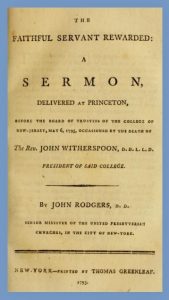 With the battles of Lexington and Concord having been fought in April 1775, and the importance of New York City to the British well recognized by its residents, many were seeking places to live outside the city believing attack was likely. Rodgers moved his family to just outside the city for safety. As war preparations and actions progressed, the British amassed an army and great fleet of ships for battle; it was clear that New York was in danger and there was also concern for the immediate surrounding area. Believing he needed to relocate further away from the city, Rodgers relocated in May 1776 to Greenfield, Connecticut, for “a place of more comfortable retirement and greater safety” (209).
With the battles of Lexington and Concord having been fought in April 1775, and the importance of New York City to the British well recognized by its residents, many were seeking places to live outside the city believing attack was likely. Rodgers moved his family to just outside the city for safety. As war preparations and actions progressed, the British amassed an army and great fleet of ships for battle; it was clear that New York was in danger and there was also concern for the immediate surrounding area. Believing he needed to relocate further away from the city, Rodgers relocated in May 1776 to Greenfield, Connecticut, for “a place of more comfortable retirement and greater safety” (209).
The chaos and uncertainties of the Revolution resulted in Dr. Rodgers providing ministry through several venues. Early in the war, he became Chaplain Rodgers for General Heath’s brigade. He resigned the chaplaincy in November 1776 after just a few months and went to Savannah. At the time, Rev. John Joachim Zubly was the pastor of the city’s Independent Presbyterian Church. During a visit by Zubly to New Jersey the previous year, he lodged with the Rodgers family, so the Savannah visit included visiting Zubly. When Rodgers returned to New York from Georgia he again moved his family, this time to Sharon, Connecticut, where they spent the winter of 1777-78 while General Washington and his troops were at Valley Forge. The Rodgers then relocated to Danbury for a brief tenure in a church. He then accepted a call from the congregation in Laminton in Hunterdon County, New Jersey, and he was installed in May 1780 to continue shepherding until the end of the war.
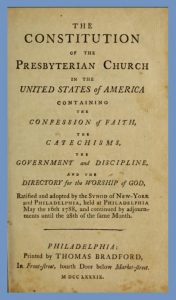 After the American Revolution officially ended with the Treaty of Paris in September 1783, the British troops evacuated New York on November 25th. When the Rodgers family returned to the city they found it in sad shape with considerable damage. Both the Wall Street and Brick Churches were damaged heavily, the parsonage was burned down, and there was a great debt accrued because of rent that was due the City of New York. While their church properties were being reconstructed, the congregation was allowed to use the former Church of England buildings of St. George’s and St. Paul’s on alternate Sundays for worship. This arrangement was followed from November 1783 until June 1784. The Brick Church on Beekman Street was damaged less than the Wall Street Church, so it was repaired first and reopened on June 27, 1784. The church appealed to the city to have both their delinquent rents for the war years cancelled and requested a reduction in rent from that point forward, both of which were granted. The Wall Street Church began its repairs in the fall of 1784 and completed them in June 1785. As things returned to normal, James Wilson was called to assist Rodgers with his growing ministry in the city.
After the American Revolution officially ended with the Treaty of Paris in September 1783, the British troops evacuated New York on November 25th. When the Rodgers family returned to the city they found it in sad shape with considerable damage. Both the Wall Street and Brick Churches were damaged heavily, the parsonage was burned down, and there was a great debt accrued because of rent that was due the City of New York. While their church properties were being reconstructed, the congregation was allowed to use the former Church of England buildings of St. George’s and St. Paul’s on alternate Sundays for worship. This arrangement was followed from November 1783 until June 1784. The Brick Church on Beekman Street was damaged less than the Wall Street Church, so it was repaired first and reopened on June 27, 1784. The church appealed to the city to have both their delinquent rents for the war years cancelled and requested a reduction in rent from that point forward, both of which were granted. The Wall Street Church began its repairs in the fall of 1784 and completed them in June 1785. As things returned to normal, James Wilson was called to assist Rodgers with his growing ministry in the city.
On May 23, 1785, the Synod of New York and Philadelphia appointed a committee to compose a Presbyterian Church constitution patterned after the one used in Scotland. The membership included—John Rodgers, John Witherspoon, Robert Smith, Patrick Allison, Samuel Stanhope Smith, John Woodhull, Robert Cooper, James Latta, George Duffield, and Matthew Wilson. The synod meeting of 1786 appointed an additional committee to establish a general assembly and its constituent synods. The members of the new committee were mostly from the one that had been working on the constitution. By 1788, the constitution was completed, adopted, and copies were ordered to be printed for distribution. In 1789, the First General Assembly of the Presbyterian Church in the United States of America was held in Philadelphia with its moderator none other than Rev. John Rodgers, D.D.
 As the collegiate congregation distributed among the two churches grew, ministers Rodgers and colleague John McKnight found themselves unable to attend to all the needs of the flock. The problem was exacerbated by the fact that McKnight’s health was in decline. Thus, Samuel Miller was called, November 20, 1792, to become the third minister on staff. The increasing congregation and the need for a church in the north-east part of the city led to construction of a church on Rutgers Street that is currently at a different location with the name Rutgers Presbyterian Church. It was dedicated on May 13, 1798, and Dr. Rodgers delivered the sermon using, as he had previously done for the Brick Church dedication, Haggai 2:7 for his text (the sermon barrel is not a recent development).
As the collegiate congregation distributed among the two churches grew, ministers Rodgers and colleague John McKnight found themselves unable to attend to all the needs of the flock. The problem was exacerbated by the fact that McKnight’s health was in decline. Thus, Samuel Miller was called, November 20, 1792, to become the third minister on staff. The increasing congregation and the need for a church in the north-east part of the city led to construction of a church on Rutgers Street that is currently at a different location with the name Rutgers Presbyterian Church. It was dedicated on May 13, 1798, and Dr. Rodgers delivered the sermon using, as he had previously done for the Brick Church dedication, Haggai 2:7 for his text (the sermon barrel is not a recent development).
With the continued growth of New York and extension of the ministry of the Presbyterians, a fourth church was built during Rodgers ministry. It opened in the spring of 1807 on Cedar Street between Nassau and William Streets and is currently at a different location with the name of Fifth Avenue Presbyterian Church. The first pastor, John B. Romeyn, was unanimously elected, left his call in Albany, and was installed the minister on November 9, 1808. The collegiate ministry of the congregation distributed in the Wall Street, Brick, and Rutgers Street churches ended in 1809 when they became separate congregations. Thus, during Dr. Rodgers’s ministry he had seen the establishment of three new church locations in addition to the original Wall Street Church. In May 1810, Gardiner Spring was called to assist Rodgers and was ordained and installed on August 8, 1810.
As Rodgers weakened with age, the session allowed him to preach only once each week on the Lord’s Day. His decline in health began with a loss of memory which led to his using sermon notes after years of preaching with none. His colleague Samuel Miller commented that “the failure of his memory, especially at some times, was so great, that he was unable to go through the service without giving more or less pain, both to himself and his hearers” (280). He delivered his last exposition in September 1809.
Early in January 1811, aging pastor Rodgers retired to his bed room where he continued to weaken. Samuel Miller was present when Dr. Rodgers passed away in the afternoon of May 7, 1811, after sixty-three years of ministry. His funeral was held in the Brick Church on Thursday, May 9, with Rev. Philip Milledoler delivering the sermon. He was survived by his wife Mary, one daughter, Mrs. Susannah Tennent, who was the widow of the recently deceased Rev. William M. Tennent, D.D, and one son, Dr. John R. B. Rodgers, a physician who studied medicine with Benjamin Rush.
Dr. Rodgers enjoyed many honors and opportunities during his long life. As has been mentioned, he was moderator of the first General Assembly of the PCUSA. In April 1765, he was elected a trustee of what is currently Princeton University and continued in the office until he resigned in 1807. Princeton had honored him with a Doctor of Divinity in 1760.
The story behind his Doctor of Divinity from the University of Edinburgh is interesting. George Whitefield was visiting in London and wanted to honor Rodgers. Whitefield communicated his desire to a friend likewise visiting London, Benjamin Franklin. Franklin agreed with Whitefield and wrote Dr. Robertson, the principal of the University of Edinburgh, asking him if the university could give Rodgers an honorary degree. Enthused by the proposal, Robertson agreed with Whitefield and Franklin. The honorary degree was given and a few weeks later Franklin received official notification of the honor, which he then sent to Whitefield, who then sent it to John Rodgers. The degree bore the date, Dec. 20, 1768, and Rodgers did not receive it until April 1769. It seems there is truth in the importance of who you know.
Dr. Rodgers was not a writer. His collegiate congregation, the years as a Princeton University trustee, and work as a churchman constituted his interests and ministry. The following list constitutes a few of his multitude of sermons published. In his day, the sessions of churches, individuals hearing a minister preach, or a congregation might ask a visiting minister for a copy of his sermon for publication. Religious, and believe it or not, public newspapers, often published sermons which were sometimes reprinted in pamphlet form. In the case of Rodgers, who generally preached without notes, a stenographer was sometimes hired to take down the sermon in anticipation of publication.
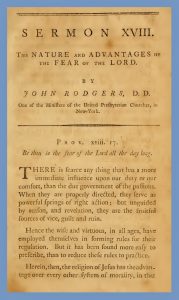 Holiness the Nature and Design of the Gospel of Christ, A Sermon Preached at Stockbridge, June 24, 1770
Holiness the Nature and Design of the Gospel of Christ, A Sermon Preached at Stockbridge, June 24, 1770
The Divine Goodness Displayed in the American Revolution: A Sermon Preached in New York, December 11, 1783; Appointed by Congress, as a Day of Public Thanksgiving throughout the United States
The Faithful Servant Rewarded: A Sermon, Delivered at Princeton, before the Trustees of the College of New Jersey, May 6th, 1795, Occasioned by the Death of Reverend John Witherspoon
A Charge Delivered to the Reverend Joseph Bullen, At His Designation to the Office of Missionary to the Chickasaw Indians
The Presence of Christ the Glory of a Church: A Sermon Delivered November 6th, 1808, at the Opening of the Presbyterian Church in Cedar Street, New York
He also published four sermons in the 4 volume set titled, The American Preacher, which was published in Elizabeth Town, New Jersey, 1791-1793. In vol. 1 is found, “The Nature and Advantage of the Fear of the Lord,” Proverbs 23:17, 339-354; in vol. 2 is the sermon, “A Caution against Declension in the Ways of Practical Piety,” Galatians 6:9, 267-283; and in vol. 3 are, “The Value of the Soul,” and “The Danger of Losing the Soul,” both from Matthew 16:26, 335-353, 355-371.
Barry Waugh
Notes—The Reformed Dutch Church sometimes made use of the collegiate system for its congregations. An example of a RDC collegiate congregation is mentioned in the Presbyterians of the Past biography of John Henry Livingston. In terms of his importance to his denomination, Livingston was to the Reformed Dutch as John Witherspoon was to the Presbyterians. The picture of the elderly man with the glasses and bald crown is Samuel Miller in his later years; a picture of him at a younger age was not available.
Sources—the great majority of the material in this biography was found in Samuel Miller’s book, Memoirs of the Rev. John Rodgers, D.D., Late Pastor of the Wall Street and Brick Churches, in the City of New York, New York: Whiting and Watson, Theological and Classical Booksellers, 1813, the page numbers referenced in the Presbyterians of the Past biography of Rodgers refer to this book. Some of the information about Rodgers and Zubly was found in The Journal of the Reverend John Joachim Zubly, A.M., D.D., March 5, 1770 through June 22, 1781, Georgia Historical Society Collections, Vol. XXI, ed. Lilla M. Hawes, Savannah: The Georgia Historical Society, 1989. A helpful book is The Presbyterian Church in New York City, by Theodore Fiske Savage, The Presbytery of New York, 1949, which includes an index of the ministers that have served in the presbytery with their churches and service dates. Another beneficial title that provides information about the Synod of New York is Robert Hastings Nichols’s, Presbyterianism in New York State: A History of the Synod and its Predecessors, Philadelphia, which was published for the Presbyterian Historical Society by The Westminster Press, 1963. The black and white portrait of Rodgers at the beginning of the biography is from the frontispiece of Samuel Miller’s memorial.


